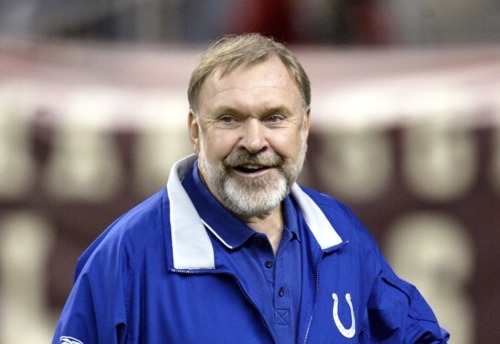
The perception of Howard Mudd seems to have shifted since training camp began, as Mudd went from a mythical offensive line genius to a real coach who makes some downright questionable decisions. In the last month he’s kicked to the bench productive veterans just because they didn’t meet his standards, forced a new and completely opposite blocking system on his players, disrupted the stable parts of the line, promoted inexperienced rookies to starting spots with the team, and then pulled one out again.
Considering one of the hallmarks of a good line is consistency, these changes don’t bode well for keeping Michael Vick off his back. I had reservations a couple months ago, back when I only had circumstantial evidence for Mudd being overrated.
Then it was a just question. Now it’s a certainty in my mind. Mudd rode a decade-plus of seemingly great lines in Indianapolis to achieve his respected status. Turns out, that was probably a lie.
Back in July, I described how Mudd’s lines ruled Football Outsiders’ Adjusted Sack Rate, a statistic that takes into account total sacks, pass attempts, situation, and defense. The Colts were either first or second in the NFL for Adjusted Sack Rate in ten of the twelve years he was their coach. And the only two years in which the Colts weren’t that high, their offensive line was still ranked in the top ten.
The problem is, that doesn’t take into account the quarterback effect of Peyton Manning, which in this case is huge. Peyton has successfully avoided sacks his entire career, despite pressure that his offensive line let through.
To prove this, all we have to do is look at the sacks and pressure stats collected by Pro Football Focus. In 2008 and 2009, the average NFL offensive line gave up pressure on the QB on 15.4 percent of pass attempts and sacks on 3.6 percent of attempts. On average, offensive lines gave up one sack for every four non-sack pressures. In other words, for every five pressures there was one sack — a reasonable conclusion.
The Colts, during that same span, gave up fewer sacks: only 1.4 percent of all attempts. And yet the line also allowed much more non-sack pressure than average: 18.6 percent of dropbacks. In the end, Manning was sacked only once for every 14 non-sack pressures, an incredibly low figure.
Let me reiterate. The Colts line gave up over 20 percent more regular pressure than the average club. And yet they allowed fewer sacks. Presumably, Mudd isn’t some rogue genius at preventing pressure from becoming sacks. That quality would fall on probably the best quarterback in the NFL over the last decade, who’s arrival in Indianapolis happened to coincide with Mudd’s.
Mudd may still be a good hire, we can’t know how he’ll do in Philly. But his reputation appears largely undeserved — more of a lucky pairing than any particular coaching brilliance. And that only further highlights the questionable offensive line shakeup he’s undertaken since he arrived.
Photo from Getty.